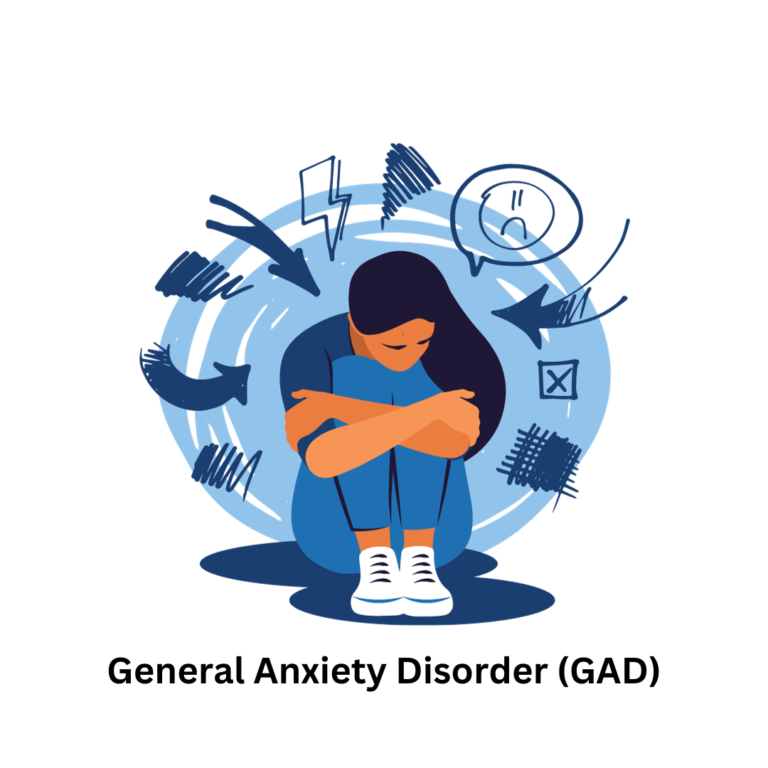
Living with Generalized Anxiety Disorder (GAD) can feel overwhelming, as this condition involves persistent, excessive worry about a wide range of everyday events and activities. Whether it’s health, work, relationships, or daily responsibilities, the anxiety associated with GAD can interfere with life, making even the simplest tasks seem daunting. However, with the right strategies and support, managing GAD is possible. In this article, we’ll explore how to navigate life with GAD and maintain a sense of well-being.
Understanding Generalized Anxiety Disorder
GAD is a type of anxiety disorder characterized by chronic, exaggerated worry and tension. Unlike normal anxiety, which can be triggered by specific events, GAD involves ongoing worry that is often disproportionate to the situation and may last for months or years.
Common Symptoms of GAD:
- Excessive worrying that is difficult to control
- Restlessness or feeling on edge
- Difficulty concentrating or having your mind go blank
- Muscle tension, headaches, or fatigue
- Difficulty falling asleep or staying asleep
- Irritability
These symptoms may vary in intensity over time but tend to interfere with daily life, leading to challenges at work, in relationships, and in overall health.
1. Recognizing the Signs of GAD
The first step in navigating life with GAD is recognizing and understanding the signs. Many people may experience occasional anxiety, but GAD is marked by worry that is persistent, all-encompassing, and difficult to manage.
If you find that you:
- Worry excessively about a variety of things most days for at least six months
- Experience physical symptoms such as tension, fatigue, or sleep problems
- Have trouble controlling your worry, despite understanding it may be excessive
… then it may be time to talk to a healthcare provider about the possibility of GAD.
2. Seek Professional Help and Treatment
GAD is a treatable condition, and seeking professional help is essential. Treatment often involves a combination of therapy, medication, and lifestyle changes.
Therapy:
- Cognitive-behavioral therapy (CBT) is one of the most effective forms of therapy for GAD. CBT helps you identify and challenge negative thought patterns and replace them with more balanced, realistic ways of thinking.
- Mindfulness-based therapy can help you focus on the present moment and reduce the cycle of worrying about the future.
Medication:
- Antidepressants, such as selective serotonin reuptake inhibitors (SSRIs) or serotonin-norepinephrine reuptake inhibitors (SNRIs), are commonly prescribed to help regulate mood and reduce anxiety.
- Anti-anxiety medications, such as benzodiazepines, may be used short-term, but they are typically not recommended for long-term use due to the risk of dependency.
It’s important to work closely with your doctor to find the right treatment plan for your needs.
3. Adopt Practical Coping Strategies
In addition to professional treatment, there are practical strategies that can help you manage GAD on a daily basis. Here are some tips to keep anxiety in check:
Create a Routine:
- Having a structured daily routine can help reduce uncertainty, which often triggers anxiety in people with GAD. Try to incorporate consistent wake-up and bedtimes, regular meals, and time for relaxation into your daily schedule.
Break Down Tasks:
- Large tasks can feel overwhelming, especially when you’re dealing with chronic anxiety. Break big projects into smaller, more manageable steps, and focus on completing them one at a time. This helps prevent feelings of being overwhelmed and gives you a sense of accomplishment.
Limit Information Overload:
- With GAD, it’s easy to get caught in a cycle of seeking constant reassurance or over-researching potential worries, especially when it comes to health or global events. Limit your exposure to news or social media if you notice it heightens your anxiety.
Practice Grounding Techniques:
- When anxiety peaks, it can feel like your thoughts are spiraling out of control. Grounding exercises, such as the 5-4-3-2-1 technique, help you reconnect with the present moment by identifying five things you can see, four things you can touch, three things you can hear, two things you can smell, and one thing you can taste.
4. Prioritize Physical Health and Wellness
Taking care of your physical health plays a crucial role in managing anxiety. A healthy body supports a healthy mind, and lifestyle changes can help reduce the intensity of GAD symptoms.
Exercise Regularly:
- Regular physical activity is one of the most effective ways to reduce anxiety. Exercise releases endorphins, which are natural mood elevators, and helps relieve muscle tension that often accompanies anxiety. Aim for at least 30 minutes of moderate exercise most days of the week.
Eat a Balanced Diet:
- What you eat can influence your anxiety levels. Avoid excessive amounts of caffeine and sugar, as they can exacerbate feelings of anxiety. Instead, focus on whole foods like fruits, vegetables, lean proteins, and whole grains to maintain stable blood sugar levels and promote overall health.
Sleep Hygiene:
- Lack of sleep can worsen anxiety. Develop good sleep hygiene habits by keeping a regular sleep schedule, avoiding screens before bed, and creating a relaxing bedtime routine. Aim for 7-9 hours of sleep each night to support mental health.
5. Strengthen Emotional and Social Support Networks
5. Strengthen Emotional and Social Support Networks
Having a strong support network is vital for managing GAD. While it’s common to want to retreat during moments of high anxiety, isolation can often make the situation worse. Here’s how to build and maintain a supportive environment:
Open Up About Your Anxiety:
- Sharing your experiences with trusted friends, family members, or a therapist can help relieve some of the burden of anxiety. It can also help others understand what you’re going through and how they can offer support.
Join a Support Group:
- Many people find comfort in connecting with others who also experience anxiety. Support groups (online or in person) allow you to share coping strategies and feel less isolated in your experiences.
Set Boundaries:
- While it’s important to have supportive people in your life, it’s equally important to set boundaries. Some individuals may unintentionally contribute to your anxiety. Be clear about your limits and practice saying “no” when needed.
5. Strengthen Emotional and Social Support Networks
Having a strong support network is vital for managing GAD. While it’s common to want to retreat during moments of high anxiety, isolation can often make the situation worse. Here’s how to build and maintain a supportive environment:
Open Up About Your Anxiety:
- Sharing your experiences with trusted friends, family members, or a therapist can help relieve some of the burden of anxiety. It can also help others understand what you’re going through and how they can offer support.
Join a Support Group:
- Many people find comfort in connecting with others who also experience anxiety. Support groups (online or in person) allow you to share coping strategies and feel less isolated in your experiences.
Set Boundaries:
- While it’s important to have supportive people in your life, it’s equally important to set boundaries. Some individuals may unintentionally contribute to your anxiety. Be clear about your limits and practice saying “no” when needed.
6. Embrace Mindfulness and Relaxation Techniques
Mindfulness is the practice of staying in the present moment and observing your thoughts and feelings without judgment. Incorporating mindfulness and relaxation techniques into your daily routine can help manage the symptoms of GAD.
Deep Breathing:
- Simple deep breathing exercises, such as diaphragmatic breathing, can calm the body’s stress response and lower anxiety. Take slow, deep breaths in through your nose and exhale slowly through your mouth, focusing on the breath to bring yourself back to the present.
Progressive Muscle Relaxation (PMR):
- PMR is a technique that involves tensing and relaxing different muscle groups in the body to reduce physical tension. It helps you become more aware of where you carry stress and teaches your body to relax more effectively.
Meditation:
- Regular meditation helps train the mind to let go of anxious thoughts and focus on the present. Whether it’s guided meditation or a simple quiet sitting practice, daily meditation has been shown to reduce the intensity of anxiety symptoms.
7. Accept That Some Worry Is Normal
A significant part of managing GAD involves accepting that some level of worry is natural and inevitable. Trying to eliminate all worry is unrealistic and may lead to even greater anxiety. Instead, focus on managing and responding to your worries in healthier ways.
Challenge Negative Thoughts:
- When anxiety strikes, ask yourself whether your worry is rational or exaggerated. Cognitive reframing can help you view situations more objectively and reduce catastrophic thinking.
Schedule Worry Time:
- If your worries are persistent throughout the day, try scheduling a specific time (e.g., 15 minutes) to focus on your concerns. This can help prevent anxiety from taking over your entire day and give you more control over your thoughts.
Conclusion
Navigating life with Generalized Anxiety Disorder requires patience, self-awareness, and proactive strategies. While GAD can be overwhelming, it’s important to remember that it’s a manageable condition. By seeking professional help, building a supportive environment, and adopting effective coping techniques, individuals with GAD can lead fulfilling lives.
Embrace small, consistent changes, and remember that you don’t have to face anxiety alone—help and support are always available.
